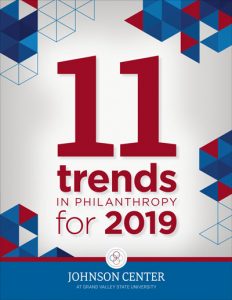Nonprofit Media Is Experiencing a Growth Spurt — So Is Philanthropy’s Response


This trend has been building for a decade: more U.S. news outlets are adopting a nonprofit model and looking to philanthropy to survive. The Knight Foundation’s 2019 commitment to double its investment in independent journalism to $300 million over five years is indicative of the sector’s response, but both nonprofit media and philanthropy have a long way to go to figure each other out.
In this piece from our 11 Trends in Philanthropy for 2019 report, our own Tory Martin outlines the reasons behind the rise of nonprofit media and the efforts many funders are making to stabilize the free press. Download and read the full report, featuring all 11 trends, here.
 While the freedom of the press has been enshrined in our Constitution for over 225 years, the press has never been free from politics. After all, President John Adams signed the Alien and Sedition Acts — effectively criminalizing public, printed opposition to the government — before the Bill of Rights was even a decade old.
While the freedom of the press has been enshrined in our Constitution for over 225 years, the press has never been free from politics. After all, President John Adams signed the Alien and Sedition Acts — effectively criminalizing public, printed opposition to the government — before the Bill of Rights was even a decade old.
Still, the crisis of confidence facing today’s media is happening within a unique context: the Digital Age. Free online platforms like Craigslist (whose founder Craig Newmark has now pledged over $50 million toward reviving U.S. media [Streitfeld, 2018]) dramatically undercut local advertising sales at the same time that 24-hour news channels and online media outlets began generating compelling competition to traditional print journalism. The 2008 financial crisis accelerated the decline (Nisbet, Wihbey, Kristiansen, & Bajak, 2018).
Consequently, the news industry is eroding. According to the Pew Research Center, newsroom employment dropped by 23 percent between 2008 and 2017, representing the elimination of some 27,000 journalists. Newspapers have felt the brunt of this loss: 45 percent of newsroom jobs have disappeared (Pew Research Center, 2018).
These major cutbacks, according to the Institute for Nonprofit News (INN), are fueling the growth of nonprofit news outlets. In their 2018 report, “INN Index: The state of nonprofit news,” INN notes that three-quarters of nonprofit news organizations launched within the last decade. These organizations remain heavily reliant on philanthropic dollars: 90 percent of their total revenues come from charitable sources (Institute for Nonprofit News, 2018).
Existing, for-profit media outlets are also flirting with the nonprofit model. In late 2017, both the Guardian and The New York Times announced the establishment of nonprofit wings.
Philanthropy is taking note. Frequently led by the John S. and James L. Knight Foundation (a constant leader in this space), Democracy Fund, and others, philanthropy is pouring new money and emphasis into nonprofit journalism and media literacy. Today, Media Impact Funders (MIF) counts 9,000 funders in the landscape. Increasing demand for MIF’s expertise led to a 2018 grant from the Wyncote Foundation to update their “5 Things” handbook for funders wishing to enter the space.
“In 2017, NewsMatch helped galvanize $33 million in donations, including gifts from 43,000 individuals who gave to nonprofit journalism for the first time.”
Some funders are working to expand giving within the general public. In December 2016, the Knight Foundation launched NewsMatch, now housed at the Miami Foundation, for just this reason. In 2017, NewsMatch helped galvanize $33 million in donations, including gifts from 43,000 individuals who gave to nonprofit journalism for the first time. Overall, 2017 was a record-breaking year for giving to nonprofit journalism in the U.S (Knight Foundation, 2018).
But where philanthropy will go from here is still unclear. A 2018 study from the Shorenstein Center on Media, Politics and Public Policy revealed that public radio and television received 44 percent of the grant dollars in this space 2010-2015. And while only 5 percent went to local/state-specific outlets, 20 percent of that number came from just one source: the Knight Foundation (Nisbet, Wihbey, Kristiansen, & Bajak, 2018).
Skeptics point to the fact that most media funding goes to a comparatively limited number of outlets (e.g., ProPublica, The Texas Tribune, NPR), recapitulating institutional funders’ tendency towards “pack philanthropy,” and that journalism funders have not yet found a balance between general support for a free press and their desire to gain coverage for specific issues and influence public opinion. As philanthropy pays increasing attention to journalism’s role in civil society, these issues are likely to come up repeatedly.
Other questions remain to be answered. Practitioners like Miguel Castro at the Gates Foundation are right to question whether Jeff Bezos’ purchase of The Washington Post, Laurene Powell Jobs’ Emerson Collective’s majority stake in The Atlantic, and Marc Benioff’s purchase of TIME constitute philanthropy or business. So far these corporate billionaires don’t seem to have overstepped the editorial firewall (Castro, 2017). But as Americans of all stripes and sectors continue to debate the virtues — and existence — of a free press, it behooves philanthropy to pay attention.
Castro, M. (2017, December 5). Overview: The pursuit of mutually assured survival. Alliance, 22(4). Retrieved from https://www.alliancemagazine.org/feature/pursuit-mutually-assured-survival
Institute for Nonprofit News. (2018). INN Index: The state of nonprofit news. Retrieved from http://inn.org/innindex
Nisbet, M., Wihbey, J., Kristiansen, S., & Bajak, A. (2018, June 18). Funding the news: Foundations and nonprofit media. (Working paper.) Co-published by the Shorenstein Center on Media, Politics and Public Policy at the Harvard Kennedy School, and Northeastern University’s School of Journalism. Retrieved from https://shorensteincenter.org/funding-the-news-foundations-and-nonprofit-media
Pew Research Center. (2018, July 30). Newsroom employment dropped nearly a quarter in less than 10 years, with greatest decline at newspapers. Retrieved from http://www.pewresearch.org/fact-tank/2018/07/30/newsroom-employment-dropped-nearly-a-quarter-in-less-than-10-years-with-greatest-decline-at-newspapers
Streitfeld, D. (2018, October 17). Craig Newmark, Newspaper Villain, Is Working to Save Journalism. The New York Times. Retrieved from https://www.nytimes.com/2018/10/17/technology/craig-newmark-journalism-gifts.html